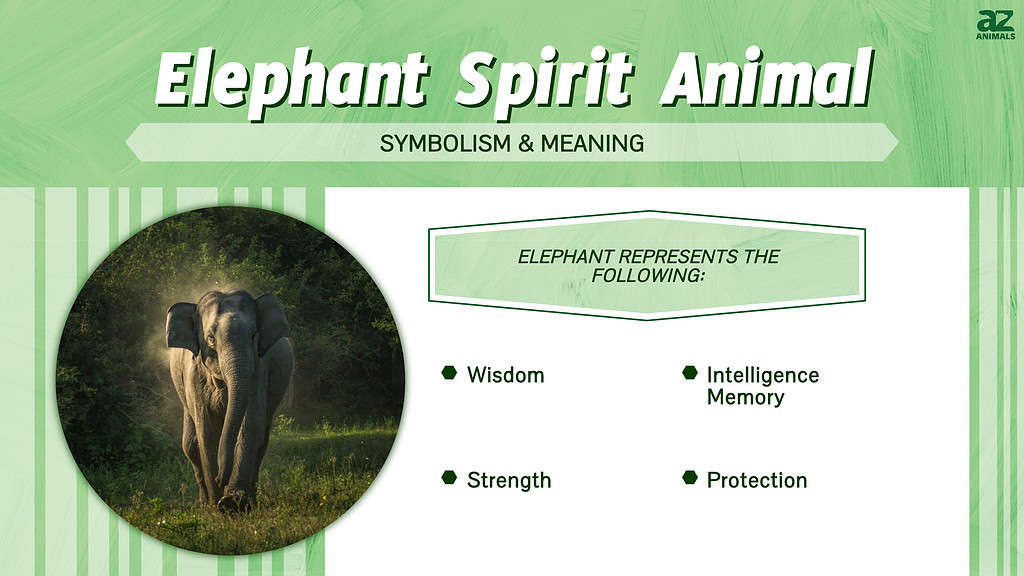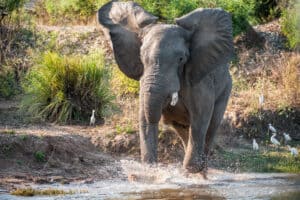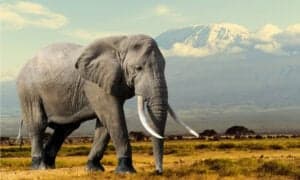
Many nations worldwide derive fantastical meaning from the world around them and the animals with whom they share their world. Elephants are native to Africa and Asia and are featured in many mythological and cultural traditions.
What Is a Spirit Animal? Can Elephants Be Spirit Animals?
Simply put, an elephant cannot be a spirit animal. The term Spirit Animal is unique to the Native, Indigenous, and First Nations people, specifically those in North America. As elephants are not native to North America, they cannot be considered a spirit animal.
Additionally, the First Nations and Indigenous populations find it rather offensive when others appropriate the term “Spirit Animal.” Spirit animals are a sacred cultural zeitgeist to the Indigenous and First Nations peoples. We should treat them with exceptional respect.
For more information on spirit animals, consider reading this article from the National Museum of the American Indian. It explains why adopting spirit animals and clans into your “ideology” is offensive to them. This article from Discover Magazine also elevates crucial Native voices in the conversation.

Elephants are not native to North America, so they cannot be considered a spirit animal.
©Kalana Premawardana/Shutterstock.com
What Does the Elephant Symbolize?
Of course, the exact symbolism of the elephant will change based on what culture you’re researching. However, most cultures view the elephant positively as a symbol of power for its prowess in war. Thus, many African and Asian religions view the elephant with great reverence. On the other hand, however, there are some cultural depictions of the elephant as a negative symbol.
Generally, elephants symbolize wisdom, intelligence, memory, strength, and protection. This comes from the elephant’s high intelligence, exceptional memory, and ability to discern and act upon emotions. They’re even intelligent enough to return to a corpse and desecrate it in cold blood! In addition, elephants are the largest and strongest land mammal on Earth. It makes sense to revere this powerful creature; after all, 300 people die in India yearly in elephant-related conflicts.
Cultural Depictions of Elephants Worldwide
Most cultural depictions of elephants come from African and Asian cultures, where these animals natively inhabit and live amongst humans. However, depictions of elephants date back to the Stone Age, where we can see them represented in ancient petroglyphs and cave art. Today we see depictions of elephants in art, film, music, and even architecture.
Prehistoric Depictions
As we mentioned, the depiction of elephants began in the prehistoric ages. As far back as the Stone Age, North African peoples have depicted the elephant as a symbol of power, longevity, and intelligence. Many African cultures and tribes continue to revere the elephant as a symbol of strength and wisdom.
Some prehistoric depictions of elephants include a rock carving at the Libyan Tadrart Acacus, the Neolithic rock art of south Oran, and a white elephant painting in “Phillip’s Cave” in Namibia. Additionally, there are elephant images from the San bushmen in the South African Cederberg Wilderness Area that experts think suggest that the bushmen had a “symbolic association with the elephant.” Research also suggests that the bushmen had “a deep understanding of the communication, behavior, and social structure of elephant family units.” They may have “developed a symbiotic relationship” with the elephants that possibly lasted thousands of years.
Ancient
The depictions of elephants did not stop once we left the prehistoric age. As civilizations cropped up, so did their beliefs surrounding the animals they lived near. Ancient Indian rock reliefs often depicted elephants, with the most notable example of such being the Descent of the Ganges at Mahabalipuram. Additionally, at Unakoti, Tripura, there is a set of reliefs dating back to the 11th century that depicts the Goddess Shiva with several elephants.
Asian Depictions of Elephants
As Asian elephants are (obviously) native to Asia, these gentle giants are featured in the cultures of Asia almost universally, both in ancient and modern times. Several gods and goddesses are depicted living alongside these giant animals or as elephants themselves in Asian cultures.
Ganesha
Ganesha goes by many names, including Ganapati, Vinayaka, and Pillaiyar. However, his elephant head is one of his most defining and notable characteristics. He is among the most well-known and widely worshipped deities in the Hindu pantheon. Ganesha is considered the Supreme God in the Ganapatya sect of Hinduism.
Hindus do not only worship Ganesha; Jains and Buddhists also widely worship Ganesha. His presence is known in Sri Lanka, Nepal, Thailand, Indonesia (Islands of Java and Bali), Singapore, Malaysia, the Philippines, and Bangladesh. Ganesha is also widely worshipped in places with large Indian populations, such as Fiji, Guyana, Mauritius, and Trinidad and Tobago.
Ganesha is considered the God of Wisdom, aligning his depiction with other depictions of elephants worldwide. He is worshipped as the God of Luck, New Beginnings, and the Remover of Obstacles.
Airavata
Airavata is a five-headed elephant who carries the deity Indra. The name “Airavata” means “belonging to Iravati,” referring to Airavata’s mythological father, Iravati, to whom he is the third son.
Airavata is depicted in many different forms throughout Southeast Asia, where his names include Erawan, Abhra-Matanga, and Naga-Malla. In addition, Airavata is often depicted in Southeast Asia with three heads instead of five. Still, in some traditions, he can be described with upwards of 33 heads.
Airavata is featured on many Southeast Asian flags, including the former flag of Laos, the former flag of Thailand (called Siam at the time,) and the flag of the Bangkok Metropolitan Administration.
Girimekhala
Girimekhala is a giant elephant that carried Mara in the Theravada sect of Buddhism. According to legends, Girimekhala was 250 yojanas tall. A yojana is an ancient unit of measurement used in India, Thailand, and Myanmar, equal to 12–15 kilometers. So Girimekhala was about 3750 kilometers tall.
Girimekhala was the mount of Mara, who attempted to stop the future Buddha from achieving enlightenment using his evil army in Theravada scripts. However, when he did, the Buddha asked the Earth to bear the testimony for his deeds, and Girimekhala fell before the might of the Buddha’s spirit.
Vinayaki
Vinayaki is an elephant-headed goddess in the Hindu tradition. However, she only appears sparingly and does not even have a consistent name throughout her depictions. Due to her elephant features, she is often associated with Ganesha, and many of her names, such as Stri Ganesha Vainayaki, Gajananā, Vighneshvari, and Ganeshani, are all feminine forms of the name Ganesha. She is often considered the shakti — or female form — of Ganesha because of her elephantine features and her name being associated with Ganesha.
Sometimes Vinayaki is considered one of the 64 yoginis or Matrika goddesses. However, scholar Krishan believes that the three distinct goddesses are Vinayaki, the shakti of Ganesha, and the Tantric yogini.
African Depictions of Elephants
We have many depictions of elephants from Africa. However, there is less textual lore that we can draw upon when trying to understand them. Many of the depictions of elephants we see in Africa are cave paintings and ancient rock art that depict elephants without an explicitly religious or cultural motive. However, the elephant is depicted on the coat of arms of the Ivory Coast.
There are more than a few African myths surrounding the elephant. Some say the elephant was once a human woman whose husband tricked her into taking the form of an animal. Another myth tells of a man who stole a female elephant’s skin and forced her to live as his human wife. A third tale tells of a struggle between the mighty elephant and a crocodile that explains why the elephant’s trunk is so long.
Kamba Tribe of Kenya
The Kamba tribe of Kenya tells the story of a poor man who heard of a successful and generous person named Ivonya-Ngia (He Who Feeds the Poor). Upon arriving at the mansion of Ivonya-Ngia, he was offered 100 cattle and 100 sheep. However, he refused this charity, instead asking for Ivonya-Ngia’s secret to success.
The man was given an ointment and told to rub it on his wife’s canine teeth. After he convinced her to allow him to do this, her teeth grew into large ivory tusks. The husband ripped the tusks out and sold them, then eagerly rubbed the ointment on his wife’s teeth again.
However, this time she didn’t allow him to pull the tusks out; eventually, her body turned grey, and she transformed into an elephant. She then fled into the wild, never to be seen again.
Chad
A similar myth from the nation of Chad tells of a hunter who discovered a beautiful elephant skin in the forest. He took it and later found a young woman crying about losing her clothes. He took her in and married her, but eventually, she found her skin and escaped back into the forest with it.
Shamanistic Depictions of Elephants
Kasogonagá
Kasogonagá is a shamanistic weather spirit who takes many forms but is often described as a multicolored elephant that throws lightning from its mouth.
According to legend, a man found Kasogonagá collapsed on the ground, having fallen from her cloud. He cared for her, and she requested that he build a fire so she could ride the smoke back up to the heavens. He obliged, and she brought rain to the parched land and granted him the powers of a shaman, telling him to ask her if he needed anything.
Final Thoughts
Elephants are majestic creatures, and it makes sense that they’d be present in so many cultures’ mythologies. Thankfully, while they have the capacity for violence, elephants are generally peaceful creatures unless bothered. We should feel blessed that Earth’s strongest and largest mammal is typically gentle toward us!
The photo featured at the top of this post is © ElephantErik/Shutterstock.com
Sources
- UniGuide, Available here: https://www.uniguide.com/elephant-meaning-symbolism-spirit-animal-guide
- American Tarantulas and Animals, Available here: https://www.atshq.org/elephant-symbolism/
- Wikipedia, Available here: https://en.wikipedia.org/wiki/Cultural_depictions_of_elephants
- Wikipedia, Available here: https://en.wikipedia.org/wiki/Airavata
- Wikipedia, Available here: https://en.wikipedia.org/wiki/Ganesha
- Wikipedia, Available here: https://en.wikipedia.org/wiki/Girimekhala
- Wikipedia, Available here: https://en.wikipedia.org/wiki/Vinayaki
- Medium, Available here: https://medium.com/elp-rumbles/elephants-in-african-myths-d4c266e1ddd9
FAQs (Frequently Asked Questions)
Where are elephants native to?
Elephants are native to Africa and Asia.
What does the elephant symbolize?
Elephants generally symbolize wisdom, intelligence, memory, and power. However, they can sometimes be used as a depiction of a great burden.
What is the most well-known depiction of elephants?
Ganesha is likely the most well-known cultural depiction of an elephant.
When did humans first start depicting elephants?
Elephants appeared in human cave art and rock art as far back as the Stone Age.
Are elephants a religious symbol?
Elephants are religious symbols in shamanism, many African nations’ cultures, Buddhism, Jainism, and Hinduism.
Thank you for reading! Have some feedback for us? Contact the AZ Animals editorial team.






